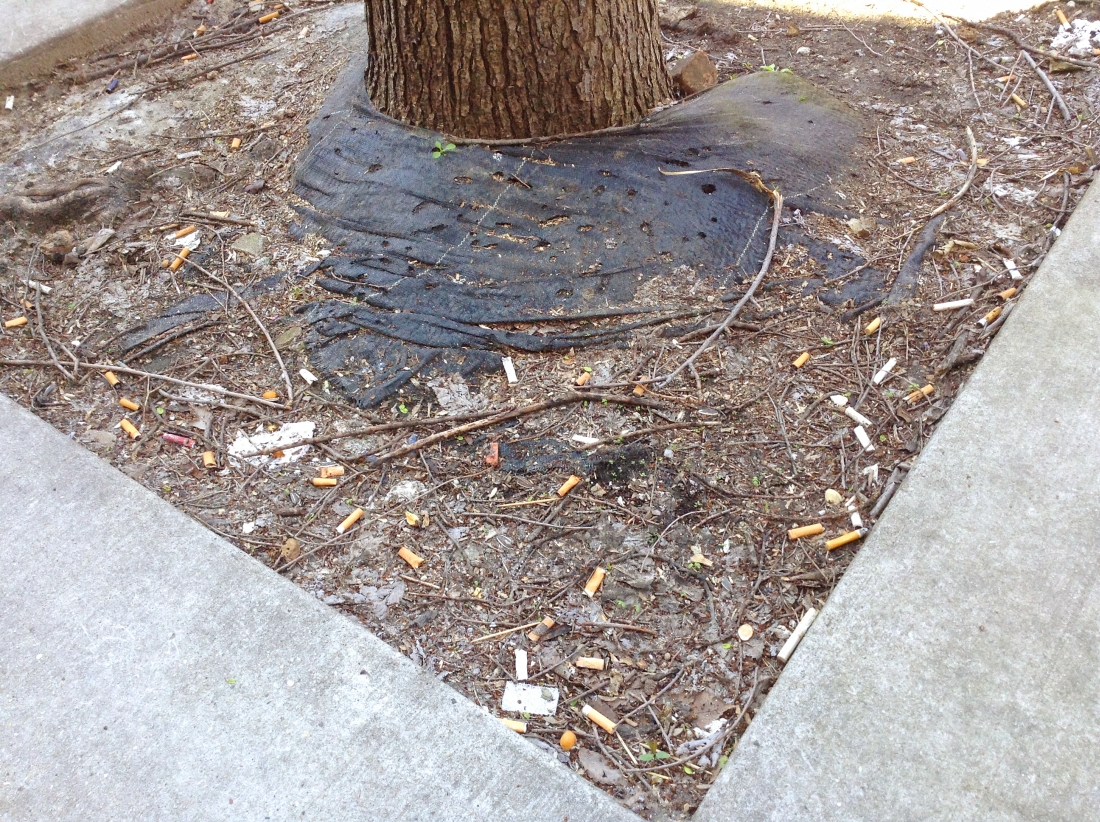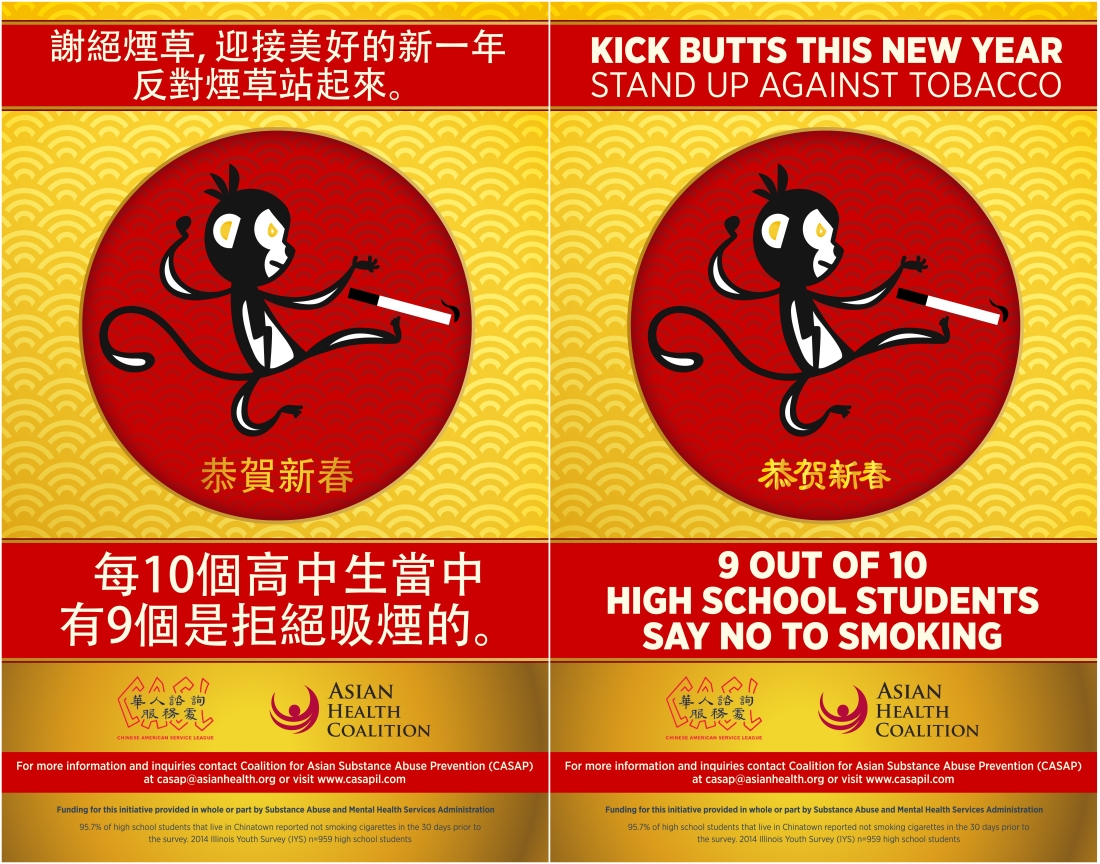By Ruojing Liu
Cigarette butts litter the streets in Chinatown. The Respiratory Health Association (RHA) collaborates with the Asian Health Coalition to organize students for a tobacco litter clean-up there on World No-Tobacco Day each May 31st. They meet in Chinatown Square. As in the past, volunteers can expect to fill dozens of clear jars with cigarette butts, said Todd Fraley, health policy analyst at RHA.
Chicago’s Chinatown, just off the Red Line south of the Loop, is home to about half of all 48,000 Chinese Americans residing in Chicago.
Mikki Lin, 21, comes out from the Kung Fu Tea located on the second floor of Chinatown Square. He leans against the fence overlooking the statues of the 12 animals of the Chinese zodiac, lights a cigarette and chat with his friends for a couple of minutes before going back to work.
Lin is currently a second-year language student at Columbia College, planning to enroll in a major once his English meets the school’s standard. He usually works part-time at Kung Fu Tea, the popular Chinese-style specialty drink shop every Friday and Saturday from 11 a.m.-1 a.m. the next day.
The business sees a continuous flow of customers, especially on weekends. For Lin, similar to many other Chinese-Americans who work at Chinatown, smoking is part of the relaxing break he can take every few hours from the busy work pace.
Lin came to America from Guangdong, China, with his parents at the age of 15 and became a ninth-grader at Benito Juarez Community Academy, a Latino-concentrated high school near Chinatown. He only knew the basic “Hello” and “How are you” in English at that time. The differing accents of his Hispanic classmates compared to his own made it even harder for him to communicate beyond the circle of about 10 other Chinese students in the same school. Naturally, he was only able to make friends with the Chinese students attending the same school. The stress of school and misunderstandings with a girlfriend added to his frustration and stress. He started smoking – just like half of his Chinese-American friends.
“It made me feel relaxed and helped take my mind off things,” Lin said. He could still remember when he stole the Marlboro from his father. “I thought I could quit anytime I want to,” Lin said.
As the emotional and habitual dependency grew on him, Lin started smoking half a packet of cigarettes every day and he had plenty of company, he said.

Yet the statistics seem to tell a different story. According to the National Health Interview Survey conducted by the Centers for Disease Control and Prevention, the smoking rate among Asian- Americans in 2014 was 9.5 percent, the lowest among all race and ethnic groups. Whites and blacks smoke at rates of 18.2 percent and 17.5 percent respectively. The Illinois Behavioral Risk Factor Surveillance System (BRFSS) run by the CDC in collaboration with the Illinois Department of Public Health offers a similar perspective, with a 2014 smoking rate of 9.6 percent within the survey’s race group of “other,” which includes Asian-Americans. Again, they rank lowest in comparison to whites at 25.9 percent and the blacks at 17.1 percent.
It’s easy to conclude that Chinese-Americans, constituting about one-third of the entire Asian-American population in Chicago, represent a “model community” when it comes to tobacco use. However, Lin and others who live in Chinatown, or perhaps Allante Sandifer, who delivers mail for the U.S. Postal Service in the neighborhood, will tell you this just isn’t true.
“They start out very young smoking in this continuous daily habit, like it’s normal for them, you see that it’s brought on from generation to generation,” said Sandifer. “They just stand around, smoking cigarettes in groups.”
Sandifer said smoking in Chinatown is far more prevalent than she sees in Calumet Heights, the community where she lives. A bunch of people standing on the streets, holding coffee cups in their hands, smoking and chatting is just another common morning scene in Chinatown. “It is part of their life,” she said.
China is currently the world’s largest tobacco consumer and producer. According to statistics released by China National Health and Family Planning Commission, China has more than 310 million smokers, and the smoking rate for age 15 and above is 28.1 percent, and more than half of the country’s adult male population smokes.
In contemporary Chinse culture, smoking is part of the social milieu, especially for men. Offering cigarettes to others is considered a sign of respect and politeness, and is also a way to initiate a conversation among friends or strangers. So, the smoking and chatting that Sandifer talks about is a natural way for Americans of Chinese descendants to interact with each other. Then, how does a culture with such a strong social link to smoking suddenly becomes part of the “model community” in official reports?
Dr. Jing Zhang, then community health program director for Asian Human Services, said in a 2011 Chicago Tribune article that the total rate of Asian-American smokers was low but that tobacco use in some groups including the Chinese was very prevalent. How can it be possible that the Asian-American’s main population groups smoke a lot but the total smoking rate remains low?
Fraley worries that the official reports, especially on the local levels, don’t have enough samples for Asians to draw an accurate and meaningful conclusion.
“We believe that IDPH’s BRFSS is a huge problem, because it lumps together Asian Americans in this ‘other’ category,” said Kevin Trieu, program coordinator at Asian Health Coalition. “It just doesn’t give a good representation of the Asian-American community in Illinois.”
But Trieu worries even more about the language issue behind the official statistics. Many new Asian immigrants like Lin do not speak fluent English, or almost none at all. But the smoking rate surveys, including the BRFSS, are often written only in English or the questions are asked in English in the case of phone surveys.
“This greatly reduces the amount of people that you can survey, especially [among] us Asian-Americans where the language barrier is so wide and prevalent,” said Trieu.
Still not fluent in English, Lin said he would never have undertaken a survey in English.
The Coalition for Asian Substance Abuse Prevention, which includes the Asian Health Coalition as a crucial member, has monitored smoking rates among students from sixth-12th grade every other year, specifically in the Greater Chinatown area that includes Armour Square and Bridgeport. After surveying 982 high school students of all ethnic groups in the area, the study showed that smoking rate among these students has dropped from 11 percent in 2012 to 6 percent in 2014. The rates for Illinois and Chicago in 2013 are 14.1 percent and 10.7 percent, according to the CDC’s Youth Risk Behavior Surveillance System.
But Trieu said he is curious to see how the numbers in Chicago’s Chinatown change after seeing a report released by the CDC in April . The report shows that, although general tobacco use among U.S. high school students hasn’t changed significantly in the past four years, the rate of e-cigarette smoking has increased roughly tenfold during the same period – from 1.5 percent in 2011 to 16 percent in 2015.

Smoking in the U.S. is more troublesome than in China, since long-existing laws like the Chicago Clean Indoor Air Act prohibit smoking as well as vaping in virtually all enclosed public places. Individual violators and business owners who allow such violations may face fines of various amounts, while such laws have just started to emerge in recent years in major cities in China and has not been carried out strictly since.
Trieu also referred to the preventative measures in place here in the U.S. to explain a lower youth smoking rate in Chinatown compared to China. Strict cigarette advertising laws that specify where tobacco retailers can sell and who they can sell to are also not well enforced in Asian countries, he said.
These measures have made access to tobacco products more difficult for youngsters who haven’t formed a habit of smoking. Yet, the Chinese-American community also suffers the same problem as every other community does – the underground cigarette market and influence from peers and family members. Lin said chances were high that he wouldn’t have started smoking if his friends didn’t and if his father didn’t.
Lin has discovered the side effects of smoking on his health and on his father’s health. He can’t catch his breath when running or doing heavy lifting, he said. On a recent winter vacation, he tried and went without cigarettes for a month. But after school resumed and the stress started kicking in, he resorted to smoking again. Now, he’s trying to limit the smoking to two to seven cigarettes a day.
Right now, the Asian Smokers’ Quitline, operated by the Moores Cancer Center at the University of California, San Diego, provides free nationwide services in Cantonese, Mandarin, Korean and Vietnamese. A study led by Dr. Shu-Hong Zhu in 2010 on the California Smokers’ Helpline, operated under Zhu’s direction by the Moores Center, shows that smokers speaking Asian languages used a telephone-based cessation service as frequently as most other smokers did.
According to the U.S. Census Bureau, the population of Americans of solely Asian ancestry has increased more than 10 percent from 2010 to 2014, making it one of the fastest growing population in America. Yet its living status is constantly overlooked.
“There isn’t much that we know because of a lack of culturally [focused] research on this growing community in the U.S.,” Trieu said. “We are slowly starting to change that, but we have a long way to go.”


